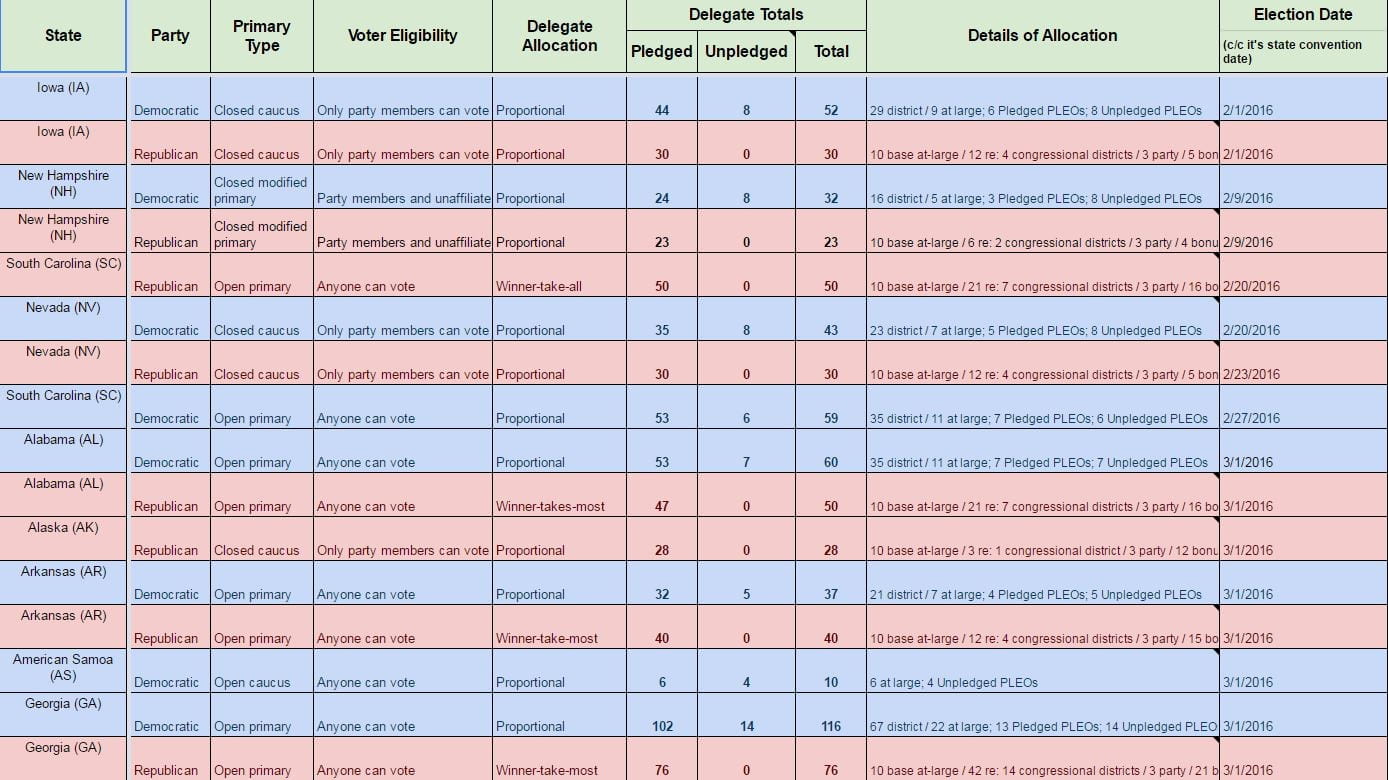By this point you’ve probably heard some of the complaints about presidential primaries: the Democratic Party’s “superdelegates” undermine the will of the people; caucuses limit participation by average voters; and states like Iowa and New Hampshire have undue influence in choosing the eventual nominees.
When we launched the USC Project on Presidential Primaries last December, our goal was to create a crowdsourced and comprehensive resource that would illuminate the system of presidential primaries and answer key questions about how primaries work in each state. Through our research, we found some support for each of the critiques above, but we also found some things we didn’t expect. It turns out that the process of picking our presidential candidates is even more opaque and incoherent than most Americans realize. Here are a few findings from our research so far:
1) Rules vary dramatically by state and party, and change from election to election
Each political party has total autonomy over how their primaries are conducted, when they occur, and how delegates are selected and allocated. While the initial rules are published a year or two before the election – in what the Democratic and Republican parties refer to as their “Convention Call” – the parties can and do continue changing the rules all the way up through their conventions.
For example, the RNC has several opportunities to modify its rules in the coming months in ways that could dramatically alter the electoral equation: during its spring meeting on April 20-22, on the eve of the convention, and during the convention when rules must be approved. As Jeff Berkowitz recently explained on Medium, opportunities to change the rules could take on special significance for Republicans this year because of Rule 40. Originally designed to protect Mitt Romney from challengers in 2012, now Rule 40 could result in Donald Trump being the only candidate on the ballot at the GOP Convention in July. (In a recent twist, Ben Ginsberg, the lawyer who masterminded Rule 40 as Romney’s campaign attorney in 2012, now says it was a temporary rule that doesn’t apply to 2016.)
If you’re interested in more of the head-spinning details about primary rules, Josh Putnam’s Frontloading HQ blog provides an excellent running commentary on how the rules are changing nationally and state-by-state.
2) Because the rules are complicated and always changing, everyone including party officials are confused by them
The biggest problem we identified in our research is that there is no single, reliable source where voters and party officials can see all of the most important and up-to-date rules in each state. The Call of the Convention is the closest thing each party has to such a resource, but it is incomplete and, as mentioned before, subject to change. That’s why we created this spreadsheet of the relevant rules, dates, and delegate counts for each state.
The resource we started is only as good as the official source material, and unfortunately we found that these official sources at the state and party level are often out of date or in conflict with each other. Because of this, we resorted to making phone calls to Republican and Democratic officials in each state. Sometimes these calls helped us clarify discrepancies, and other times they led to more confusion.
For example, we made two calls to the Republican Party in Colorado and got two different answers regarding how their delegates would be allocated at the GOP Convention. First, a party official told us that delegates tend to publicly declare a preference before they are elected, which means they are “legally bound” to that candidate at the GOP Convention. But in a follow-up call, a different official told us that unpledged delegates are not bound to any candidate in any official or legally-binding way. Colorado is unique in that all 37 of its delegates are technically unpledged, so having a clear and consistent answer to this question seems important.
3) The press is paying attention, but also getting things wrong
Compared to past electoral cycles, the media has paid quite a bit of attention to the party rules during this primary season. But because the rules are so complicated, the media often misreport the details and distort the reality of how candidates are chosen. For example, because they don’t effectively distinguish between delegates and superdelegates, most major media outlets continue to suggest that Hillary Clinton has secured almost twice as many delegates as she actually has, when in reality the race between her and Bernie Sanders is still quite close.

Why should you care?
The confusion surrounding primary rules allow the parties to make major changes, out of sight and without any input from the public, that have an impact on the outcome of the race and the options before the American public in the general election. While the system of presidential primaries we have in place today is a great deal more democratic than it was in 1968, 1912, and earlier eras, the parties effectively remain in control of which candidates the American people can consider for president – even as outsiders like Donald Trump and Bernie Sanders are challenging their traditional hegemony. This narrowing of options is not only about the DNC and RNC rules around primaries and delegates. It also extends to the media rules governing presidential debates, the barriers to candidates appearing on the ballot in each state, the rules around fundraising and political contributions, and other rules and regulations that serve to disconnect the will of the people from the interests of political parties, media outlets, and other special interests.
Stay tuned for future posts where we will begin to dig into some potential solutions and ideas for reform.
This post was researched and written by Soledad Altrudi and Rebecca Mulqueen, with additional editing and research support by Ev Boyle and Justin Chapman.

